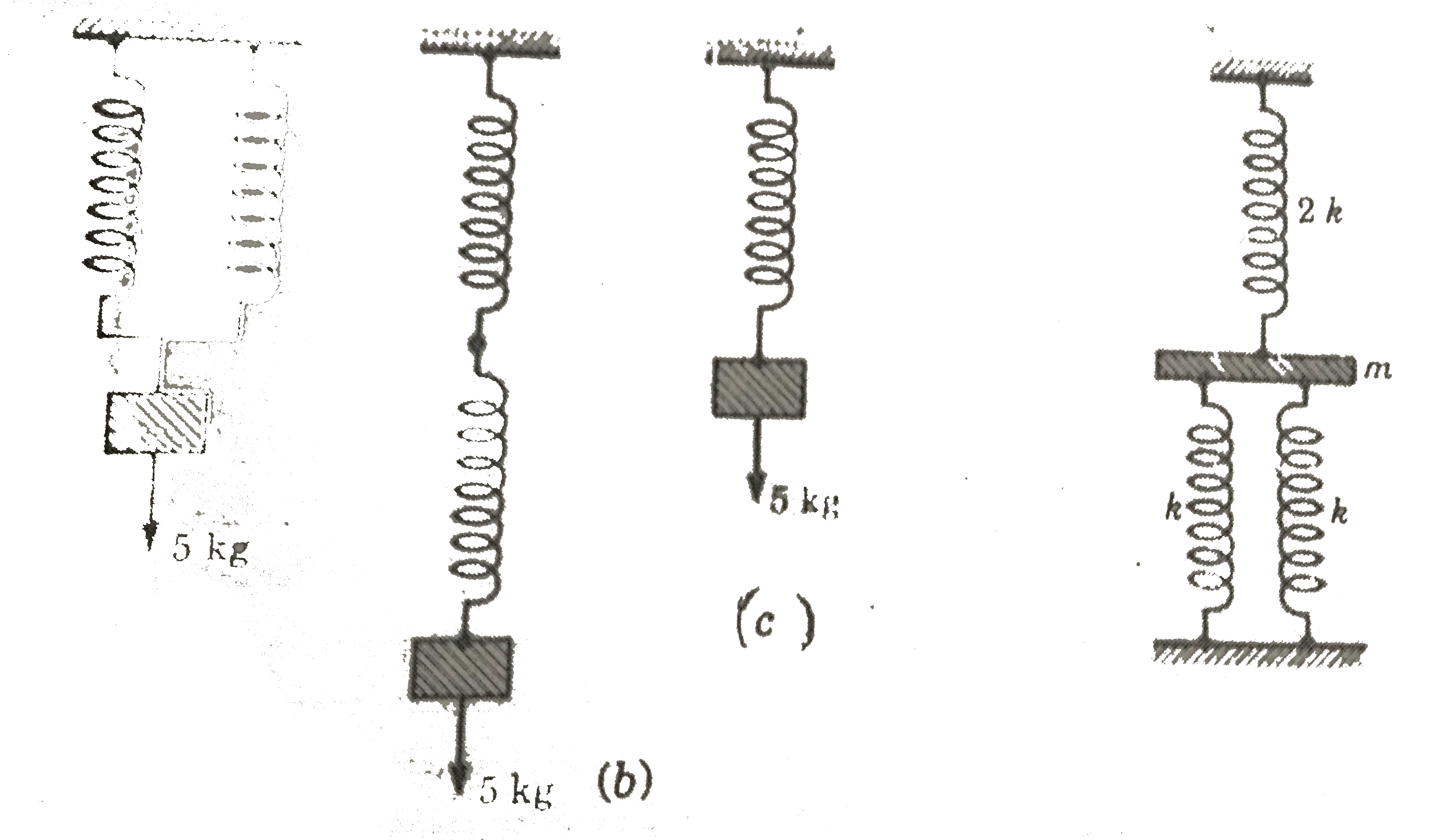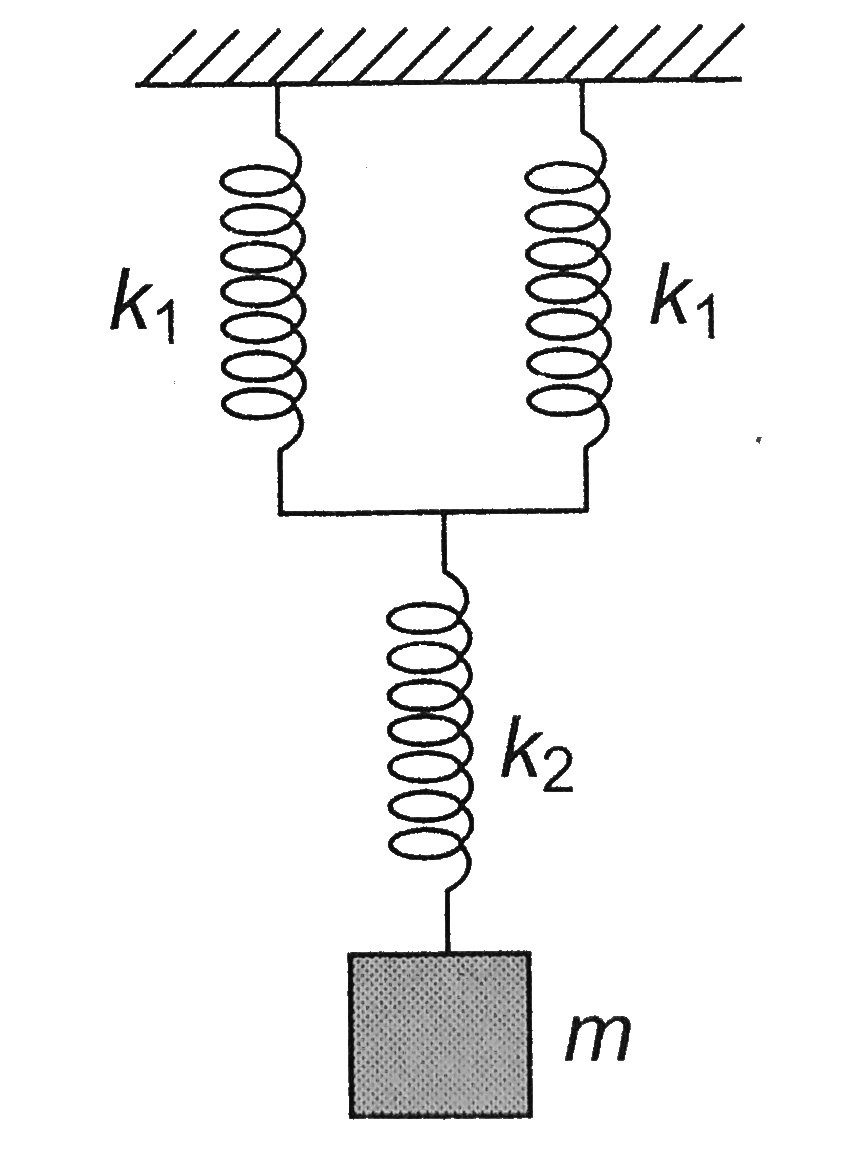Two identical springs have the same force constant of . What elongation will be produced in each spring in each case shown in figure? .

Here
In figure,
The effective spring constant,
elongation in the spring,
In figure, the effective spring constant,
Total elongation in the springs,
Thus, elongation in each spring
In figure, the effective spring constant,
elongation in the spring,
Topper's Solved these Questions
- OSCILLATIONS AND WAVESBOOK - PRADEEPCHAPTER - OSCILLATIONS AND WAVESEXERCISE - Long Answer Questions
33 Videos
- OSCILLATIONS AND WAVESBOOK - PRADEEPCHAPTER - OSCILLATIONS AND WAVESEXERCISE - Advanced Problems For Competitions
20 Videos
- OSCILLATIONS AND WAVESBOOK - PRADEEPCHAPTER - OSCILLATIONS AND WAVESEXERCISE - Very Short Answer Questions
99 Videos
- MATHEMATICAL TOOLSBOOK - PRADEEPCHAPTER - MATHEMATICAL TOOLSEXERCISE - Fill in the blanks
5 Videos
- PHYSICAL WORLD AND MEASUREMENTBOOK - PRADEEPCHAPTER - PHYSICAL WORLD AND MEASUREMENTEXERCISE - Competiton Focus Jee Medical Entrance
18 Videos
Similar Questions
Two identical springs have the same force constant of 147Nm−1. What elongation will be produced in each spring in each case shown in figure. Take g=9.8ms−2

View SolutionA mass of 1.5 kg is connected to two identical springs each of force constant 300Nm−1 as shown in the figure. If the mass is displaced from its equilibrium position by 10 cm, then maximu speed of the trolley is

View Solution
Knowledge Check
What will be the force constant of the spring system shown in figure?
 A[1k1+1k2]B[12k1+1k2]−1C[1k1+1k2]−1D[12k1+1k2]
A[1k1+1k2]B[12k1+1k2]−1C[1k1+1k2]−1D[12k1+1k2]Two springs have their force constant as K1 and K2(K1<K2). When they are stretched by the same force:
ANo work is done is case of both the springs.BEqual work is done in case of both the springCMore work done in case of second springDMore work is done in case of first springTwo springs have their force constant as k1 and k2(k1>k2). When they are streched by the same force.
ANo work is done in case of both the springsBNo work is done in case of both the springsCNo work is done in case of both the springsDMore work is done in case of first spring
In the situation shown in figure all contact surfaces are smooth. The force constant of the spring is K. Two forces F are applied as shown. The maximum elongation produced in the spring is how many times of F/K (initially the spring is relaxed)?

View SolutionNatural length of a spring is 60 cm, and its spring constant is 4000 N/m, A mass of 20 kg is hung from it. The extension produced in the spring is (take g=9.8m/s2)
View SolutionNatural length of a spring is 60 cm, and its spring constant is 4000 N/m, A mass of 20 kg is hung from it. The extension produced in the spring is (take g=9.8m/s2)
View SolutionTwo springs have their force constant as k1 and k2(k1>k2). When they are stretched by the same force.
View SolutionNatural length of a spring is 60 cm and its spring constant is 4000 N/m. A mass of 20 kg is hung from it. The extension produced in the spring is (Take, g=9.8m/s2)
View Solution
